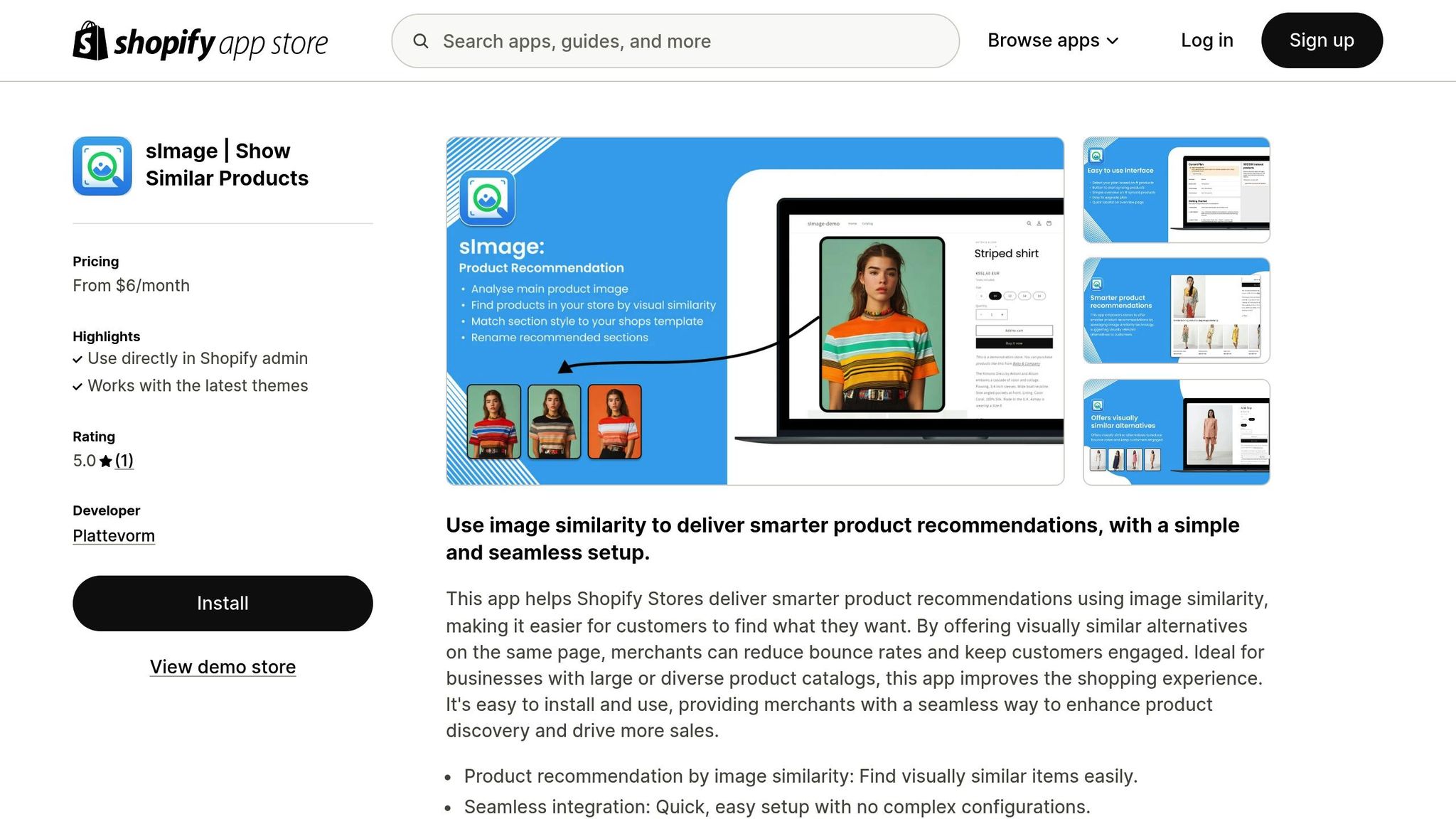How AI Improves Shopify Product Recommendations

How AI Improves Shopify Product Recommendations
AI is transforming Shopify product recommendations by analyzing product images to identify colors, patterns, and styles, delivering smarter suggestions that feel natural to shoppers. Here's how it helps:
- Better Product Discovery: AI suggests visually similar items, making it easier for customers to find related products and stay engaged.
- Increased Sales: Cross-selling and upselling improve as customers see relevant recommendations, boosting average order value and conversion rates.
- Effortless Setup: Tools like sImage require no coding, integrate seamlessly with Shopify themes, and automatically update recommendations as new products are added.
- Scalable for All Businesses: Flexible pricing plans fit stores of any size, from small boutiques to large catalogs.
Example: A store using AI-powered recommendations saw reduced bounce rates and higher sales by showing visually similar items to shoppers.
AI-powered tools like sImage simplify operations and improve the shopping experience, helping Shopify merchants grow their businesses with minimal effort.
✅ How to create Shopify product recommendations using AI (Full Guide)

How AI Changes Product Recommendations
Traditional product recommendations often miss the mark because they tend to rely on simple factors like past purchases or basic category matching. AI-powered visual merchandising takes this concept to a whole new level by analyzing product images to create smarter, more intuitive suggestions for shoppers.
How AI Visual Merchandising Works
AI uses image analysis to identify key features like colors, patterns, and styles, making it easier to match products. When a shopper views an item, the AI scans your catalog for visually similar products and suggests them. This approach ensures recommendations feel more relevant to the shopper's preferences.
This technology is particularly useful for stores with large catalogs, helping customers uncover items they might not have found otherwise.
Visual Similarity and Cross-Selling
Visual similarity is a game-changer for cross-selling because it aligns with how people naturally shop - they're drawn to items that visually complement what they’re already considering. AI enhances this by automatically spotting and recommending products that share similar visual elements with the one being viewed.
For instance, if someone is checking out a blue ceramic vase, the AI might suggest:
- Decorative plates with similar glazing
- Items in a matching color palette
- Products featuring comparable artistic designs or patterns
These visually guided suggestions not only feel intuitive to shoppers but also have a measurable impact on sales, as discussed in the next section.
Benefits of AI for Shopify Stores
Better Product Discovery
- Makes it easier for customers to find related items
- Offers relevant suggestions that keep shoppers engaged
- Creates a browsing experience with visually aligned recommendations
Streamlined Operations
- Automatically updates recommendations as you add new products
- Eliminates the need for manual tagging or categorization
- Works seamlessly with Shopify themes for easy integration
Boosted Sales Performance
- Encourages cross-selling, increasing the average order value
- Offers tailored suggestions that improve conversion rates
- Keeps customers engaged, driving overall sales growth
Whether your store has 500 products or 8,000, AI-powered recommendations adapt to your catalog, making them a powerful tool for businesses of all sizes.
Setting Up AI Image Recommendations with sImage

Quick Start Guide: sImage Setup
Getting started with sImage is a breeze. Simply install it from your Shopify admin, and the app will immediately begin analyzing your product catalog. There’s no need for coding, manual configurations, or complex setups - it’s ready to go right out of the box.
Preparing Your Product Catalog
To get the most out of AI-powered recommendations, it’s important to have a well-prepared product catalog. Follow these tips to ensure the system works at its best:
- Use high-quality images with consistent lighting and clean backgrounds.
- Showcase multiple angles of each product whenever possible.
- Keep image dimensions consistent across your catalog for a uniform look.
- Write clear and descriptive titles and product descriptions.
Organized and detailed product images make it easier for the AI to identify visual patterns and similarities. This translates to more accurate and relevant recommendations for your customers, ultimately improving their shopping experience. Once your catalog is ready, focus on optimizing where these recommendations appear to boost conversions.
Placement Tips for Better Conversion
The placement of product recommendations can make or break their impact. Here are some strategies to ensure they grab attention and encourage purchases:
- Below the Product Description: Position recommendations directly under the product details. Shoppers naturally scroll here after reviewing product information, making it an ideal spot to capture their interest.
- Mobile-Optimized Display: The app automatically adjusts layouts for different screen sizes, ensuring recommendations look great on both desktops and mobile devices.
-
Dynamic Positioning: Experiment with different placements to match your store’s layout:
- Use the sidebar for desktop views.
- Place recommendations at the bottom of the page for mobile users.
- Add them to the cart page to encourage last-minute purchases.
Scalable Pricing for Every Business
Whether you’re running a small store or managing a large catalog, sImage offers flexible pricing plans to suit your needs:
| Store Size | Monthly Price | Product Limit |
|---|---|---|
| Small | $6 | Up to 500 |
| Medium | $11 | Up to 1,000 |
| Large | $20 | Up to 2,000 |
| Pro | $35 | Up to 4,000 |
| Champion | $60 | Up to 8,000 |
This tiered pricing structure ensures that businesses of all sizes can benefit from AI-driven recommendations without overspending. As your catalog grows, you can seamlessly upgrade to a plan that matches your store’s needs.
sbb-itb-521eef9
Cross-Selling with AI Technology
Building Product Groups with AI
AI-powered image analysis is revolutionizing how stores group and recommend products. By analyzing visual elements like colors, patterns, textures, and styles, AI can create product groupings that feel natural and appealing to shoppers.
Here’s how the system works:
- Color Coordination: It identifies complementary color palettes across different categories.
- Design Recognition: It spots patterns, textures, and style details that work well together.
- Price Matching: It aligns products within similar price ranges to enhance compatibility.
This approach allows for dynamic, visually cohesive groupings that can adapt seamlessly to seasonal trends.
Seasonal Product Recommendations
Once intelligent product groupings are in place, AI takes it a step further by tailoring recommendations for each season. This simplifies seasonal merchandising by:
- Highlighting seasonal collections at the right time.
- Adapting suggestions based on evolving shopping habits.
- Refreshing product groups as new items are added.
To get the most out of these seasonal updates, keep these tips in mind:
- Regularly update your product catalog.
- Use high-quality images to showcase items.
- Remove out-of-stock products quickly.
- Continuously add fresh inventory.
With its knack for spotting visual similarities, AI ensures customers always see timely and relevant recommendations, even as seasons change.
Tracking AI Recommendation Results
Measuring Success with Analytics
Keep an eye on these important Shopify metrics to gauge how well your AI recommendations are performing:
- Conversion Rate: The percentage of shoppers who make a purchase after interacting with recommendations.
- Average Order Value (AOV): The boost in cart value driven by clicks on recommended products.
- Click-Through Rate (CTR): How often customers click on the suggested items.
- Time on Product Pages: The amount of time users spend exploring products after engaging with recommendations.
Once you've pinpointed these metrics, experiment with different layouts to see what works best for your store's audience.
Testing Different Layouts
Want to make your AI recommendations more effective? Try running A/B tests with various layouts and placements. Here are a few ideas to test:
- Positioning recommendations just below the product description.
- Adding them to a sidebar for easy visibility.
- Using pop-up displays to grab attention.
- Placing them at the bottom of the page as a final nudge.
Track the performance of each option to find the layout that not only fits your store's design but also encourages customer engagement.
Improving Results with User Data
Take your recommendations to the next level by leveraging customer behavior data. As the AI gathers more insights, it can fine-tune suggestions to match shopper preferences. Focus on these data points:
- Items that are often purchased together.
- Seasonal trends in buying behavior.
- Price ranges that resonate with your customers.
- Product categories that pair well.
To keep things running smoothly, ensure your product catalog is always up-to-date, use high-quality images, and remove out-of-stock items quickly. This helps maintain customer trust and keeps their shopping experience frustration-free.
Conclusion
AI-powered visual merchandising, combined with smart cross-selling strategies, is transforming how customers discover and connect with products. By leveraging AI-driven image analysis, merchants can offer a shopping experience that feels seamless and engaging for both sides of the transaction.
The results speak for themselves - Shopify stores have seen measurable improvements in bounce rates, as well as gains in cross-selling and upselling performance. Together, these advancements streamline customer discovery, boost operational efficiency, and unlock new opportunities for sales growth, creating a well-rounded approach to scaling online stores.
FAQs
How does AI-powered image analysis enhance Shopify product recommendations?
AI-driven image analysis takes product recommendations to the next level by spotting visual similarities between items in your store. For Shopify merchants, this means offering customers more relevant and visually engaging product suggestions, opening up new opportunities for cross-selling.
By highlighting products with similar styles, colors, or patterns, this technology creates a shopping experience that's tailored to individual tastes. The result? Customers are more likely to find items they’ll adore, increasing the chances of extra purchases and driving your sales higher.
How can AI tools like sImage benefit Shopify stores of all sizes?
AI-driven tools like sImage offer valuable benefits for Shopify stores of all sizes. By analyzing product images, these tools can recommend visually similar items, helping store owners display related products to shoppers. This approach not only enhances cross-selling opportunities but also creates a smoother shopping experience, potentially increasing both sales and the average order value.
What’s more, sImage works seamlessly with Shopify themes and doesn’t require any coding knowledge to implement. This makes it an easy-to-use and practical option for businesses aiming to improve product recommendations and encourage growth.
How can I use AI to improve product recommendations in my Shopify store?
To get the best results from AI-driven product recommendations, start with high-quality, clear product images. These images are crucial because AI tools rely on them to spot visual similarities, allowing the system to suggest related items that customers might be interested in.
This strategy not only improves cross-selling opportunities but also delivers a more tailored shopping experience, which can increase both customer satisfaction and sales. On top of that, keeping your product catalog well-organized and properly tagged ensures the AI works more effectively.